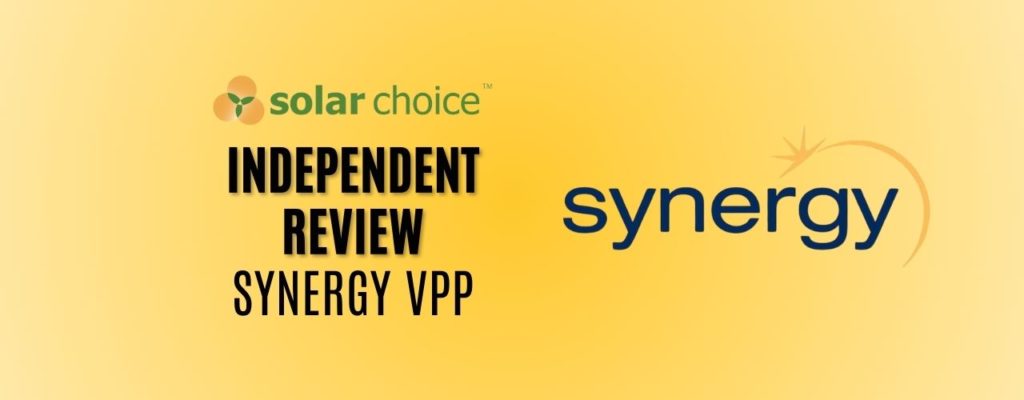Note: Solar Choice has no incentive to promote one Virtual Power Plant (VPP) program over another. This review is written to provide WA homeowners with clear, factual and unbiased information.
VPP Overview
The Synergy Battery Rewards program is Western Australia’s first large-scale Virtual Power Plant (VPP) for households on the South West Interconnected System (SWIS), which covers Perth and the state’s south‑west region. Participation in a VPP is a mandatory condition for accessing the WA Government’s Residential Battery Rebate. Homeowners can choose Synergy’s Battery Rewards or another approved VPP.
- Company: Synergy (WA Government‑owned retailer).
- Partners: WA Government and Western Power.
- Launch: 2023 (aligned with the Residential Battery Scheme).
- Scale: New program, uptake tied to rebate applications.
- Availability: Only for Synergy customers on the SWIS. Not available in Horizon Power areas (regional WA).
For more background, see our VPP explainer.
Financial Benefits Offered
- WA State Battery Rebate: $200 per kWh of capacity, capped at $2,000 (10 kWh). Horizon Power customers receive $350/kWh up to $3,500. See our WA battery rebate guide.
- Federal Battery Rebate: Up to $4,500 depending on battery size and household eligibility. See our federal rebate guide.
- Event credits: When Synergy calls a VPP event, households are paid $0.70 per kWh exported from their battery.
- Offset credits: If Synergy charges or holds your battery for an event, you receive credits so you are never left out of pocket.
- Bill savings: Your battery reduces grid purchases year‑round, and DEBS feed‑in credits continue as normal outside events.
Example savings with a 15 kWh battery:
- High‑use household: Around $1,000–$1,200 per year (daily cycling + several VPP events).
- Low‑use household: Around $500–$700 per year (less cycling + fewer events).
For guidance, see our Home Battery Storage Guide.
Electricity Tariffs & Rates
Participation requires being a Synergy electricity customer on the SWIS. Customers remain on Synergy’s regular residential tariffs such as:
- Home Plan (A1) – flat rate.
- Smart Home TOU plans – time‑of‑use rates.
Solar feed‑in tariffs under the Distributed Energy Buyback Scheme (DEBS) continue as usual for normal solar exports outside VPP events.
Compare plans here:
Live tariff lookup:
Battery and System Requirements
- Minimum size: 5 kWh usable capacity.
- Eligible systems: Must be on Synergy’s approved list (includes popular models such as Tesla Powerwall, Alpha ESS, Sungrow and others).
- Internet connection: Required for remote control.
- Smart meter: Mandatory.
- Exclusivity: You cannot join another VPP while enrolled.
- Eligibility: Must be a Synergy customer with no life‑support equipment registered at the property.
See our Solar Batteries hub for battery comparisons.
Contract Length and Exit Terms
- Contract term: 2 years.
- Events: Customers cannot opt out of individual events.
- Leaving early: You may stop receiving event credits if you leave the program, but the upfront WA rebate is not clawed back once granted.
Technical Operations
- Event frequency: Up to 30 times per year during peak demand.
- Duration: Usually 2–6 hours per event.
- Dispatch: Synergy can charge or discharge your battery to help stabilise the grid.
- Home supply priority: Your household load is supplied first; only excess power is exported.
- Backup reserve: Not guaranteed. Your battery may discharge to low levels during events.
Compare with other programs: AGL VPP, Origin Loop, ShineHub, Amber SmartShift or our VPP comparison guide.
Customer Experience
- Monitoring: Credits appear on Synergy bills. No separate VPP app.
- Support: Managed through Synergy customer service.
- Transparency: Limited reporting on individual events.
Pros & Cons
Pros
- Access to WA rebate ($200/kWh up to $2,000) plus federal rebate.
- High event credit rate ($0.70/kWh).
- Offset credits mean you never lose out on prep energy.
- Backed by Synergy and WA Government.
- Shorter 2‑year term compared with some national VPPs.
Cons
- Only available in WA (SWIS customers).
- Must be a Synergy customer to join.
- Up to 30 events per year; no ability to opt out.
- Backup power may be reduced during events.
- No dedicated VPP monitoring app.
Is the Synergy VPP Worth It?
For WA households, joining a VPP is mandatory to access the state rebate. Synergy’s Battery Rewards is the default pathway for most Perth and south‑west homeowners. It offers strong upfront savings, generous $0.70/kWh event credits, and government backing. The trade‑off is less control over your battery and limited transparency. Households focused on bill savings are likely to benefit, while those prioritising backup security may find the deep discharges less appealing.
See our Is a VPP Worth It? guide.
How to Join
- Install an eligible battery (≥5 kWh) through an accredited vendor.
- Apply for the WA rebate (vendor applies on your behalf).
- Choose an approved VPP — for Synergy customers, Battery Rewards is the main option.
- Sign Synergy’s 2‑year agreement.
- Event credits appear on your Synergy bill.
- Everything Electric Melbourne | EV Battery Health, Street Charging & Smarter Homes - 27 November, 2025
- 10 Cheapest Electricity Providers in Adelaide (Live Pricing) - 17 November, 2025
- 10 Cheapest Electricity Providers in Melbourne (Live Pricing) - 12 November, 2025
